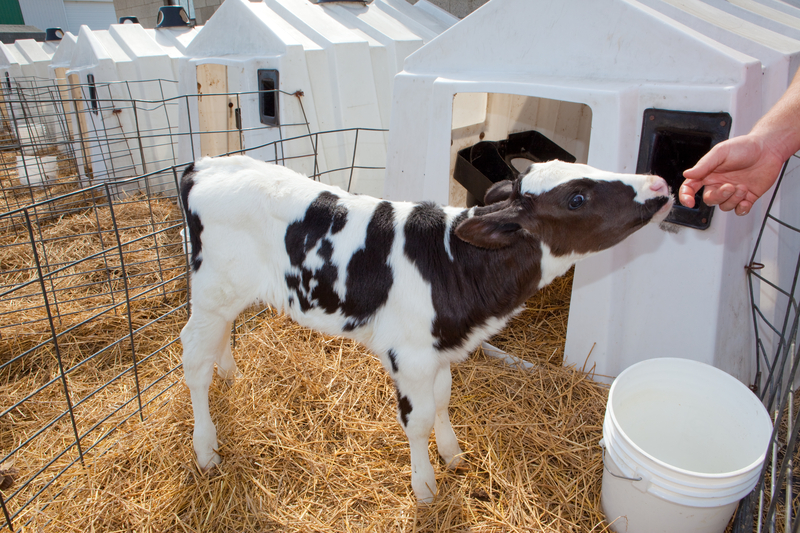 11 Jul 2022
11 Jul 2022
Rumen microbiota can be modified through the fiber supplementation in the first stages of the calf’s life.
Introduction
The gastrointestinal tract of mammals is inhabited by a symbiotic microbial community, which influences the health and growth performance of the host animals. The rumen represents a typical example of such environments, as feed ingested by ruminants is degraded and fermented primarily by highly diverse microorganisms including bacteria, archaea, fungi, and protozoa into different components such as short-chain fatty acids (SCFAs) and microbial proteins that are then available for the host.
Although the core bacterial members of rumen microbiota are widely distributed regardless of the ruminant species or breed, the relative abundance of each bacterial species within the rumen of individual animals tends to vary significantly. The relatively higher host specificity of the adult rumen microbiota is suggested by the quick reestablishment of the original bacterial community composition following a total exchange of ruminal content. Individual variations within rumen microbiota can also influence host productivity. Although the individuality of rumen microbiota can serve as a target for genetic selection and breeding, it represents one of the hurdles in manipulating rumen microbiota via feeding management to improve host productivity.

Yáñez-Ruiz et al. proposed the rumen programming concept, in which the composition of rumen microbiota is manipulated via feeding management during early life, leading to improved lifetime productivity. This concept is based on the immaturity of the rumen of pre-weaned calves in regards to microbiota composition and its functions.
In calves that are 3 weeks old, or more, solid feed intake in the form of starter diets and roughage, increases and stimulates microbial proliferation, as well as short chain fatty acid (SCFA) production. This in turn enables and contributes to rumen development.
Under normal feeding conditions, the morphological and functional development of the rumen is accelerated after 4–6 weeks of age. The calf rumen is rapidly colonized by microbes immediately after birth. Major fibrolytic bacterial species have been detected in calf rumen within the first 3 days after birth, which suggests that solid feed can be potentially digested in the rumen of calves during their early life. It is hypothesized that an increased solid feed intake during the first week of life can stimulate those microorganisms which have already colonized the rumen. Which will in turn lead to and early ruminal development.
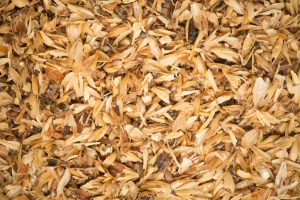
Study objective
Researchers set out to study the effects of oral administration of fiber during the pre-weaning period on the development of the rumen microbiota, from pre-weaning to the first lactation period
Bacterial colonization in the rumen of pre-weaned ruminants is vital for their post-weaning growth and productivity.
Materials and Methods
For the study, 20 calves were assigned to the control and treatment groups (n = 10 each). Animals in both groups were raised with a standard feeding schedule throughout the experiment, except for oral fiber administration (50-100 g/day/animal) from 3 days of age to weaning for the treatment group.
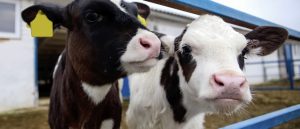
Rumen contents were collected during the pre-weaning period, the growth period and after birth.
Results
Effect of oral fiber administration on rumen fermentation and microbiota structure:
A relatively higher proportion of butyrate (P = 0.05) and a lower concentration of ammoniacal nitrogen (NH3-N) (P < 0.05) were detected in the rumen of the treatment group during the pre-weaning period, while no significant differences in the rumen fermentation parameters of adult animals were detected throughout the pre- and postpartum periods.
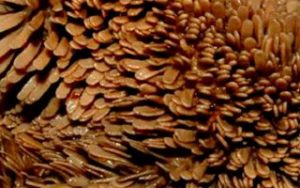
Among bacterial taxa detected through 16S ribosomal RNA (rRNA) gene amplicon sequencing in the rumen of calves 7 to 56 days of age, bacterial genera were selected that showed significant differences in their relative abundance by treatment for at least one sampling point from 7 to 56 days of age.
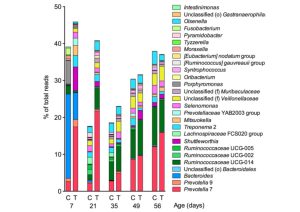
Graph1: Bacterial genera that showed significant differences over at least one age point from 7 to 56 days of age are represented in the graph. C control group, T treatment group.
Notable differences in the structure of the rumen microbiota between the control and treatment groups during the first 21 days after birth were seen. At 7 days of age, 11 taxa showed higher abundance in the treatment group, while 5 taxa showed lower abundance than in the control group.
In particular, the abundance of Prevotella 7 (17.44% vs. 2.64%, P < 0.05), Shuttleworthia (6.41% vs. 0.09%, P < 0.01), Mitsuokella (2.67% vs. 0.02%, P < 0.01), and Selenomonas (1.60% vs. 0.01%, P < 0.01). 0.01%, P < 0.01) was higher in the treatment group, while porphyromonas abundance (0.36% vs. 6.41%, P < 0.05) was lower in the treatment group than in the control group.
Although no significant differences were observed, the abundance of Bacteroides was lower in the treatment group than in the control group at 7 days of age. At 21 days of age, 9 taxa showed greater abundance in the treatment group, while 6 taxa showed lower abundance than in the control group.
Discussion
Forage supplementation in calves during the pre-weaning period shows beneficial effects, such as improved feed intake, growth performance, rumination and rumen environment.
Researchers confirmed the beneficial effect of oral fiber administration in calves from 3 days of age to weaning age; calves receiving oral fiber administration exhibited improvements in body weight and posterior bowel microbiota within the first 3 weeks after birth.
| The study revealed that oral administration of fiber to calves during the first stage of their life altered the rumen microbiota, and its effect could be lasting until the first calving. |
Diet plays an important role in the rumen microbial colonization of ruminants. Pre-weaning diets primarily determine the nature of the rumen microbiota in calves.
Therefore, oral administration of a fibrous diet from 3 days of age within this study, resulted in a higher intake of fibrous diet in calves up to 28 days of age, without affecting the intake of starter feed.
| Therefore, supplementation of calves with a fibrous diet shortly after birth leads to thw development of a distinct bacterial community in the rumen of pre-weaned calves. |
Pre-weaned calves in the treatment group shared a higher number of bacterial ASVs with those weaned over the pre-weaning period in the study, suggesting that oral fiber administration facilitates earlier colonization of rumen bacteria.
The difference in the microbial composition of the rumen between the dietary groups was observed even 21 days after delivery, with significantly higher mean milk production in the first 30 days of lactation. Therefore, oral fiber administration to calves during the pre-weaning period altered the rumen microbiota, and its effect could be long-lasting until the first calving.
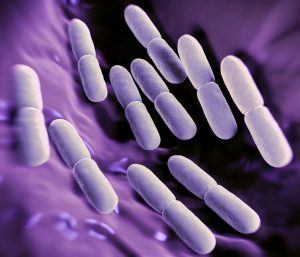
Conclusion
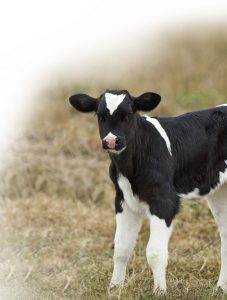
Source: Kodithuwakku, H., Maruyama, D., Owada, H. et al. Alterations in rumen microbiota via oral fiber administration during early life in dairy cows. Sci Rep 12,10798 (2022).
Subscribe now to the technical magazine of animal nutrition
AUTHORS

Nutritional Interventions to Improve Fertility in Male Broiler Breeders
Edgar O. Oviedo Rondón
The Use of Organic Acids in Poultry: A Natural Path to Health and Productivity
M. Naeem
Synergistic Benefits of Prebiotics and Probiotics in Poultry, Swine, and Cattle
Gustavo Adolfo Quintana-Ospina
Hybrid Rye Potential in Laying Hen Feed Rations
Gwendolyn Jones
A day in the life of phosphorus in pigs: Part I
Rafael Duran Giménez-Rico
Use of enzymes in diets for ruminants
Braulio de la Calle Campos
Minerals and Hoof Health in the Pregnant Sow
Juan Gabriel Espino
Impact of Oxidized Fats on Swine Reproduction and Offspring
Maria Alejandra Perez Alvarado